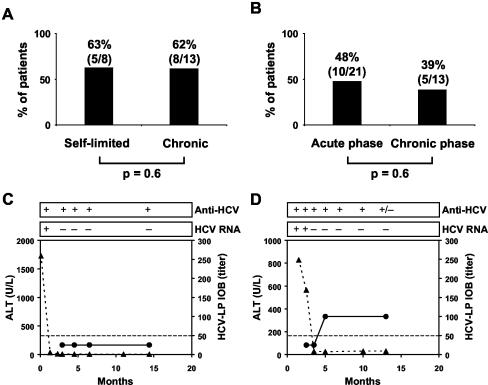FIG. 5.
Inhibition of cellular HCV-LP binding and virus clearance. (A) HCV-LP inhibition of binding activity and outcome of infection in acute hepatitis C. The graph shows the percentages of patients with sera inhibiting cellular HCV-LP binding at a titer of ≥1:50 in relation to the outcome of infection (self-limited infection versus chronic infection). (B) Inhibition of HCV-LP binding and phase of infection. The graph shows the percentages of patients with sera inhibiting cellular HCV-LP binding at a titer of ≥1:50 in relation to the phase of infection (acute versus chronic). (C and D) Serial analyses of antibodies with inhibition of HCV-LP binding activity in two patients with acute self-limited hepatitis C and virus clearance. Alanine aminotransferase (ALT) levels (triangles) are indicated on the left y axis. Titers of antibody-mediated inhibition of HCV-LP binding were determined as described in the legend to Fig. 2 and are indicated on the right y axis (circles). The x axis represents time points after the diagnosis of acute hepatitis C. The presence (+) or absence (−) of HCV RNA and anti-HCV antibodies is shown at the top; +/−, weakly positive. (C) Virus clearance in the absence of antibodies with inhibition of HCV-LP binding activity. (D) Virus clearance in the presence of antibodies with inhibition of HCV-LP binding activity.

